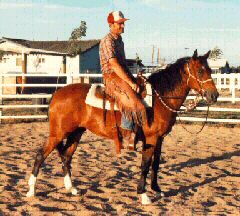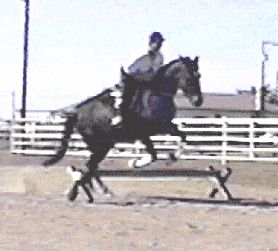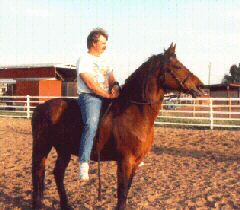KBR Horse Training Information
Exercising Body AND Mind
Success or Failure - It's Up to You!
(A Personal Commentary)

There has been much discussion in the media lately about the BLM "Adopt-
a- Horse" program. News reports have spoken of adopted horses ending up at
the slaughterhouse or becoming "missing" after adoption. Some reporters
have questioned if the are better off being adopted rather than left to
fend for themselves in the "wild".
Horses are not native to North America. As an introduced species, they
have settled in numerous regions of the United States. Adult horses don't
have any natural predators, therefore there are only two limiting factors
to their population, starvation as they outstrip the land's food supply
(which also adversely affects other grazing wildlife), or human
intervention.
Particularly during times of drought, life can be extremely hard on the
horse herds in the poorer areas and many die. In a humanitarian effort,
the BLM has established numerous Herd Management Areas (HMAs) and BLM
naturalists have estimated the populations that each HMA can adequately
support. The concept here is to remove "excess" numbers of horses, place
them in adoptive care, and in doing so give the "wild" herds as well as
native plant eating animals a chance to remain vital and healthy.
Regarding the slaughterhouse issue, federal regulations are very clear.
Horses, burros and mules may only be adopted for personal use, not for
commercial purposes or profit. It is illegal to adopt a horse and then
sell it for slaughter.
Unfortunately, horses from all walks of life are going to find their way
to the slaughterhouse. With the present shortage of beef in Europe due to
the "mad cow disease", there is high demand for horse meat. Some will
argue
that using horses for food is as logical as using cattle, however the fact
remains that it is illegal to sell off BLM horses for slaughter and the
practice needs to be stopped.
The BLM certainly doesn't condone the sending of adopted animals to
slaughter. The Adopt-a-Horse program, however, relies primarily on
volunteers in order to ensure the welfare and proper use of adopted
animals. (Due to the sheer volume of adoptions, it would be too costly to
run the program if it relied entirely on salaried governmental
personnel.)
 Another
problem involves adopters who bring home a wild horse or burro on a lark or
due to the mystique of taming a "wild" animal, and they are not prepared
for the work and patience which goes into successful gentling. Again, the
volunteers play an extremely important role in providing a support
structure
to assist inexperienced adopters and guide them through the rough spots.
Adopters need to more fully utilize the resources. Another
problem involves adopters who bring home a wild horse or burro on a lark or
due to the mystique of taming a "wild" animal, and they are not prepared
for the work and patience which goes into successful gentling. Again, the
volunteers play an extremely important role in providing a support
structure
to assist inexperienced adopters and guide them through the rough spots.
Adopters need to more fully utilize the resources.
The BLM can always use more volunteer assistance. Practical horse
experience helps, however even if you are willing to just help out and
learn, the volunteer program may well benefit from your participation.
Contact your area field office and ask to be put
in touch with their volunteer coordinator. You can do a great deal of good
and enjoy your involvement with this unique program.
 You can
also benefit the program by having the right attitude and approach if you
decide to adopt. You can
also benefit the program by having the right attitude and approach if you
decide to adopt.
Through some unusual twists of fate we ended up with two BLM horses and
a couple of burros. While we have a ranch full of horses, from minis to
drafters, the BLM animals have been very special and enjoyable to bring up.
The horses are really handy mounts and the burros are just plain fun to
have around. We are familiar with horse behavior and in a very short time
(as in a matter of days) these horses were comfortably under saddle, were
going out on trail, taking obstacles, etc. To get this kind of "rapid
response", we concentrated on tried and true principles of basic horse
behavior (many of which we are working up to share on this website).
 For those
out there who are not as well versed in the subtleties of horse
communication and social behavior, you can be equally successful. A little
patience and following the advice of those who are used to handling these
animals will bring you success, plus you will gain a great deal of
knowledge along the way which can be carried over to the handling of your
domestic horses. For those
out there who are not as well versed in the subtleties of horse
communication and social behavior, you can be equally successful. A little
patience and following the advice of those who are used to handling these
animals will bring you success, plus you will gain a great deal of
knowledge along the way which can be carried over to the handling of your
domestic horses.
If you're not too sure of yourself, adopt a horse which has already been
halter broken. These animals have had more exposure to human contact and
are less reliant on their basic wariness and flight instincts. You can
build on the gentling process which has already begun. Also, develop a
relationship with BLM volunteers in your area. They can be most
helpful.
Once you have a horse, you may find it more beneficial to have him
started by a professional. There are a number of people who are very
successful with these animals, they travel and put on group weekend
clinics, and some programs are as inexpensive as $60.00 per day. Usually
the format involves "colt starting" on Saturday with horse handling, which
oftentimes includes riding, following on Sunday.
In some instances we've seen horses started on Saturday and their owners
riding them on Sunday; walking, trotting and taking obstacles in a group
class. Thus, starting your horse does not have to be expensive, and in
many of these programs you can learn as much as your horse. The idea here
is that, apart from the initial "saddling and mounting" of the horse, you
will be involved working with your horse on a "hands on" basis. Whether
you can actually ride your horse usually depends on how well adjusted the
horse is, and how skillful you are as a rider.
 There is a great deal of good information available.
Barbara Eustis-Cross and Nancy Bowker prepared an excellent book on the
subject. Some details appear on this website in Are You Considering Adopting a Wild Horse? The
BLM has produced a number of informative brochures which are available from
any field office. They also have a recommended reading list. With some
understanding about how these animals work and what motivates them, you can
have a productive and enjoyable horse-human relationship. There is a great deal of good information available.
Barbara Eustis-Cross and Nancy Bowker prepared an excellent book on the
subject. Some details appear on this website in Are You Considering Adopting a Wild Horse? The
BLM has produced a number of informative brochures which are available from
any field office. They also have a recommended reading list. With some
understanding about how these animals work and what motivates them, you can
have a productive and enjoyable horse-human relationship.
In summary, if you're concerned about the welfare of BLM adoptees there
are many ways you can actually do something. Whether as a
volunteer or responsible adopter, you can become part of the solution
rather than merely worry about the problem.
Happy trails!
This is not a BLM operated or BLM sponsored site.
It is run by private wild horse and burro enthusiasts. The BLM, however, is
gratefully credited for the graphic images which appear on this
page. All photos are of titled BLM horses we've had here at the ranch.

Press "Back" to return to the page which brought you here
KBR Horse Training Information, © 1997 Lamm's Kickin' Back
Ranch and Willis & Sharon Lamm. All rights reserved. Duplication of any of this material for
commercial use is prohibited without express written permission. This prohibition is
not intended to extend to personal non-commercial use, including sharing with others for
safety and learning purposes, provided this copyright notice is attached.
Email us to submit comments or request reproduction
permission.
|